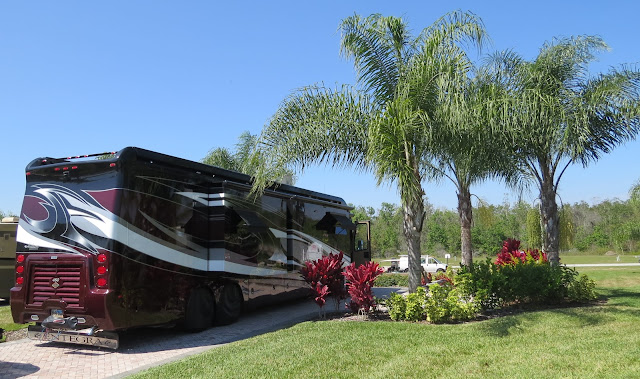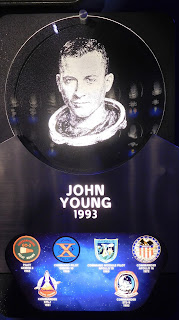“THE SKY
CALLS TO US.” CARL SAGAN
CAROL WRITES: From
the Gulf of Mexico to the Atlantic Ocean, the State of Florida is 160 miles
wide at its widest point. Our next
destination was smack in the middle of the Florida Highlands at Polk City, a
small community along Interstate 4 midway between Tampa and Orlando.
It is a fact of life that traffic on I-4 can be
insane at times, such as when the Orlando theme parks close for the day;
however, at Bay Lake Motorcoach Resort we found a sleepy, peaceful oasis.
This was one of those RV properties where
individuals can purchase their RV site outright, then amend it with structures
and landscaping in a variety of ways permitted by ownership rules. Over the past 7 or 8 years since Bay Lake
opened, only several dozen lots out of a potential of a couple hundred have
been developed, so that left a lot of open space. Most owners had charming pastel-colored mini
homes and pleasing paver driveways with parking space and utility connections for
their large motorhomes. Add in luscious
tropical landscaping and the result made for a very quaint and sweet “second
home” vacation spot for the owners.
I have borrowed a few pics below from the resort
website.

From my point of view, this place felt pretty
deserted and we had all the time and space poolside that we desired, in addition
to a lovely rural setting for our mile-or-so loop walks every day.
KENNEDY SPACE CENTER
Periodically, Al has mentioned that he sort of
regretted that we didn’t get down to Kennedy Space Center while we were in
Jacksonville. Not to worry… Florida
isn’t that wide and NASA’s ole “Cape Canaveral” was only a couple of hours
away.
Since the days of the Mercury Space Program in the
early 1960s to the final mission of the Space Shuttle in 2011, the lives of us
baby boomers have been enriched by countless inventions related to the space
program. America’s long space legacy was
lovingly preserved at Kennedy Space Center, where we enjoyed a fascinating walk
down memory lane with many highlights …
A bus tour out to the famous Vehicle Assembly
Building, where large space vehicles are constructed,
Preserved sections of primitive launch control
consoles from the early days of Project Mercury,
A look at the underside of a massive Saturn V
rocket like the one that was used to propel astronauts to the moon,
A loving tribute to three astronauts whose
lives were lost in a catastrophic fire during training in their Apollo space capsule,
and a brand new “Heroes and Legends” building with
an astronaut Hall of Fame that included some of our most notable space heroes.
Of interest to me were the front pages from
newspapers around the world that celebrated America’s achievement of landing
men on the moon. I couldn’t resist a
picture of the very Cincinnati Enquirer
newspaper that I remembered reading in 1969 when I was a young college student and
Ohio’s own Neil Armstrong was the first human to set foot on the moon.

For us, the star of the Kennedy Space Center was
clearly the eye-popping and creative display of Space Shuttle Atlantis,
mounted indoors on supports that created the
appearance of a space shuttle flying through the room,
with its cargo door open…
and Canadian robot arm extended!
Voices were quite hushed in the hallway where
tribute was paid to the astronauts who lost their lives on Challenger and
Columbia. Haunting pieces of wreckage
from each tragedy evoked much reflection.
While the end of the 6-ship space shuttle program
closed another chapter in space exploration, present-day
Kennedy Space Center was anything but inactive. Private enterprise was clearly alive and well with
SpaceX playing an increasing role in launching satellites, in addition to
payloads to the International Space Station.
The week after our visit to Kennedy Space Center, from
our own campsite we were able to watch a 2 a.m. SpaceX launch of an EchoStar
communications satellite that would enhance television viewing across Brazil. What an impressive ball of flame in the sky
80 miles in the distance!
At our campsite a few days later, we saw an early-evening
launch of an Air Force GPS satellite from its launch pad at Kennedy Space
Center.
Steven Hawking has stated that he believes the
future of the human race most likely lies in space. Thankfully, that hope is alive and well-nourished
every day at Kennedy Space Center.
BIKING THROUGH FLORIDA WETLANDS
On the outskirts of Polk City we were lucky
to discover the James A. Van Fleet state bike trail, a paved trail that runs
through 29 miles of some of Florida’s most scenic rural wetlands
landscape.
In addition to a nice tranquil bike ride, we were
hoping for some wildlife sightings, and we were amply rewarded…
We saw:
blue herons that we never tire photographing,
gopher turtles,
and huge adult alligators just along
the trail’s edge. Al encouraged me to
get a little closer for a really great pic, but of the four adults gazing at
this gator I figured I was the slowest runner, so I felt just fine where I was…
Nothing more rewarding than observing wildlife
totally in harmony with its unconstrained habitat.
BOK TOWER GARDENS
Very near the top of the list of attractions
in this part of the sleepy central Florida Highlands was an historic landmark
site called Bok Tower Gardens. This
contemplative garden and bird sanctuary, located on one of the highest points of the
Florida Highlands, was completed in 1929 and was the brainchild of a Dutch
editor and humanitarian named Edward Bok.
Al and I both had doubts that a 50-acre garden and
200-ft carillon tower would impress us all that much, but we couldn’t have been
more mistaken.
For a start, the gardens were striking and thoughtfully
varied with…
annuals at peak bloom,
and a spotlight on Florida vegetation.
Added into the mix was a tour through an historic
1920s Mediterranean-style home
with an architectural style that oozed coolness
and old-Florida allure.
However, the predominant attraction of the
day was the neo-Gothic pink stone carillon tower decorated with ironwork and
tile mosaics. Although neither of us is
particularly fond of carillon music, the St. Patrick’s Day selection of Irish
tunes had a certain toe-tapping pizzazz.
Bok tower itself was the complete Florida package,
with Florida-themed carvings of herons
and a nifty sundial.
The choice of Edward Bok’s burial site at
the foot of the golden paneled door to his beloved tower seemed quite
fitting. We ended up spending the better
part of the afternoon at Bok Tower Gardens, coming away with much more
admiration for Bok’s crowning legacy of community betterment and service to
others.










































































